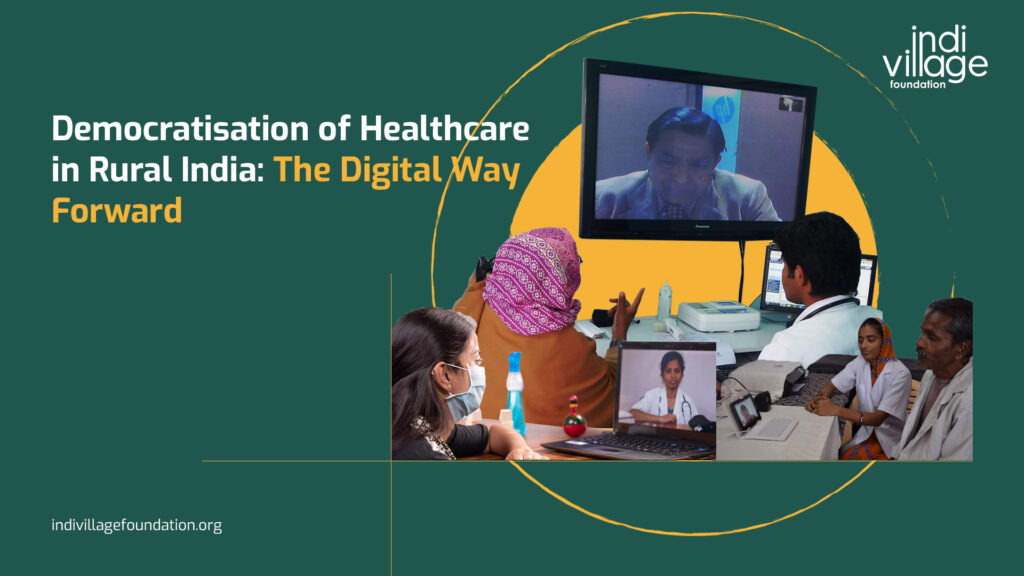DEMOCRATISATION OF HEALTHCARE IN RURAL INDIA: THE DIGITAL WAY FORWARD
The Covid-19 pandemic has engendered an unprecedented and historic shift in the way different industries operate and function. The Healthcare industry is no exception. The leaders in this industry are paving way for accustoming to the “new normal” and fighting the shrewd virus. As the new reality of the pandemic settles in, doctors and domain experts have turned to a more digitized and radical alternative of delivering healthcare, which we often call ‘telehealth’. For the past two years, Coronavirus has been one of the major catalysts in India’s digital revolution. Naturally, the digital healthcare industry, also known as Telehealth, has grown rapidly and is expected to reach $10.6 billion by 2025.
In layman’s terms, ‘Telehealth’ is the conveyance or distribution of healthcare and health-related information via technology. Live video consultations, remote patient monitoring (RPM), and democratisation of information through mobile apps are some pieces that make up the telehealth maze. Several new-age technologies like RPM, video integrations, artificial intelligence, and mobile health are utilised for telehealth. Having been widely used in the urban landscape, telehealth suffers from a lack of penetration in rural India but it is predicted as the future of India’s healthcare industry. It has the potential to close the persisting gap between rural and urban India and therefore, there is a need to bring this technology to the remotest parts of the country.
How can telehealth help people in rural India?
Telehealth facilitates a timely and inexpensive mode of healthcare. It helps increase the quality of healthcare and makes it more accessible to the masses. With telehealth, rural hospitals have the power to provide services to patients without having them travel long distances and spend huge amounts of money. This wonderful innovation, therefore, has the capability to kill two birds with one stone.
Using telehealth in rural India can help healthcare services reach the last-mile and overcome the problem of understaffing in hospitals. Programs backed by telehealth offer innovative ways of extending the reach of healthcare services and addressing a wider array of complications and diseases in rural areas. By infusing telehealth into the ecosystem, contactless delivery of speciality care will also become more widespread and lead to better monitoring and timeliness across remote regions. In addition, it will give birth to a healthcare revolution where more and more people will become aware of their physical well-being and get access to quality assistance efficiently.
The efficacy of telehealth has already reaped benefits for the majority of urban India. It’s time to make this technology more accessible and common across rural India in order to advance communities in all walks of life. The adaptation of telehealth and its related destigmatization can be accelerated in rural India in varied ways. Ensuring proper training of medical staff, improvement in internet services, development of cohesive public private partnerships, and dissemination of education related to telehealth can together contribute towards removing the bottlenecks in the rural healthcare industry.
Conclusion:
According to Niti Ayog, India has officially acknowledged the need for digital intervention in healthcare. The rapid growth in telehealth will reshape the healthcare sector not only in the urban context but also rural. The main reasons behind the staggering growth of telehealth in rural areas are the lack of awareness and unequal access to resources. Rural communities still prefer offline healthcare consultations over online services because of lack of penetration and awareness of the latter. Changing the narrative of telehealth in rural areas is therefore the need of the hour. Through a joint effort, both government and the private sector can address the gaps persisting in rural areas and work towards revolutionising the healthcare sector in India in the post-Covid-19 scenario.
At IndiVillage Foundation, we lay immense focus on bridging the gap between quality healthcare and rural India by way of strategic interventions and sustainable partnerships. In association with Project StepOne, we focus on continuously educating rural India on advanced healthcare practices and preparing them for emergencies. Click here to know more about our healthcare vertical.
Article by: Amanpreet Kaur (https://www.linkedin.com/in/kamanpreet/ )



